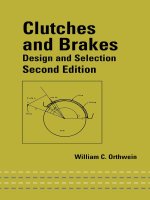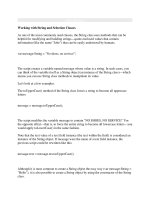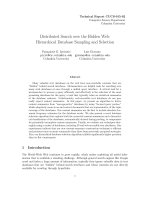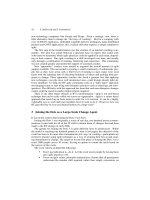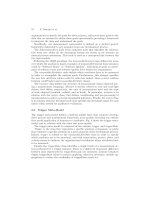Feature engineering and selection
Bạn đang xem bản rút gọn của tài liệu. Xem và tải ngay bản đầy đủ của tài liệu tại đây (4.04 MB, 94 trang )
Feature Engineering
and Selection
CS 294: Practical Machine Learning
October 1st, 2009
Alexandre Bouchard-Côté
Abstract supervised setup
• Training :
•
: input vector
xi =
xi,1
xi,2
..
.
xi,n
, xi,j ∈ R
• y : response variable
–
: binary classification
–
: regression
– what we want to be able to predict, having
observed some new .
Concrete setup
Input
Output
“Danger”
Featurization
Input
Features
xi,1
xi,2
..
.
xi,n
xi,1
xi,2
..
.
xi,n
Output
“Danger”
Outline
• Today: how to featurize effectively
– Many possible featurizations
– Choice can drastically affect performance
• Program:
– Part I : Handcrafting features: examples, bag
of tricks (feature engineering)
– Part II: Automatic feature selection
Part I: Handcrafting
Features
Machines still need us
Example 1: email classification
PERSONAL
• Input: a email message
• Output: is the email...
– spam,
– work-related,
– personal, ...
Basics: bag of words
• Input: x (email-valued)
• Feature vector:
f (x) =
f1 (x)
f2 (x)
..
.
fn (x)
, e.g. f1 (x) =
Indicator or
Kronecker
delta function
1 if the email contains “Viagra”
0 otherwise
• Learn one weight vector for each class:
wy ∈ Rn , y ∈ {SPAM,WORK,PERS}
• Decision rule: yˆ = argmaxy wy , f (x)
Implementation: exploit sparsity
f (x)
Feature vector hashtable
extractFeature(Email e) {
result <- hashtable
Feature template 1:
UNIGRAM:Viagra
for (String word : e.getWordsInBody())
result.put("UNIGRAM:" + word, 1.0)
String previous = "#"
for (String word : e.getWordsInBody()) {
result.put("BIGRAM:"+ previous + " " + word, 1.0)
previous = word
}
return result
}
Feature template 2:
BIGRAM:Cheap Viagra
Features for multitask learning
• Each user inbox is a separate learning
problem
– E.g.: Pfizer drug designer’s inbox
• Most inbox has very few training
instances, but all the learning problems
are clearly related
Features for multitask learning
[e.g.:Daumé 06]
• Solution: include both user-specific and
global versions of each feature. E.g.:
– UNIGRAM:Viagra
– USER_id4928-UNIGRAM:Viagra
• Equivalent to a Bayesian hierarchy under
some conditions (Finkel et al. 2009)
w
w
x
y
User 2
User 1
w
x
y
...
Structure on the output space
• In multiclass classification, output space
often has known structure as well
• Example: a hierarchy:
Emails
Spam
Advance
fee frauds
Ham
Backscatter
Spamvertised
sites
Work
Personal
Mailing lists
Structure on the output space
• Slight generalization of the learning/
prediction setup: allow features to depend
both on the input x and on the class y
Before: • One weight/class: wy ∈ Rn ,
• Decision rule: yˆ = argmaxy wy , f (x)
After: • Single weight:
m
w∈R ,
• New rule: yˆ = argmaxy w, f (x, y)
Structure on the output space
• At least as expressive: conjoin each
feature with all output classes to get the
same model
• E.g.: UNIGRAM:Viagra becomes
– UNIGRAM:Viagra AND CLASS=FRAUD
– UNIGRAM:Viagra AND CLASS=ADVERTISE
– UNIGRAM:Viagra AND CLASS=WORK
– UNIGRAM:Viagra AND CLASS=LIST
– UNIGRAM:Viagra AND CLASS=PERSONAL
Structure on the output space
Exploit the information in the hierarchy by
activating both coarse and fine versions of
the features on a given input:
Emails
x
y
Spam
Advance
fee frauds
Ham
Backscatter
Spamvertised
sites
...
UNIGRAM:Alex AND CLASS=PERSONAL
UNIGRAM:Alex AND CLASS=HAM
...
Work
Personal
Mailing lists
Structure on the output space
• Not limited to hierarchies
– multiple hierarchies
– in general, arbitrary featurization of the output
• Another use:
– want to model that if no words in the email
were seen in training, it’s probably spam
– add a bias feature that is activated only in
SPAM subclass (ignores the input):
CLASS=SPAM
Dealing with continuous data
“Danger”
• Full solution needs HMMs (a sequence of
correlated classification problems): Alex
Simma will talk about that on Oct. 15
• Simpler problem: identify a single sound
unit (phoneme)
“r”
Dealing with continuous data
• Step 1: Find a coordinate system where
similar input have similar coordinates
– Use Fourier transforms and knowledge
about the human ear
Sound 1
Time domain:
Frequency domain:
Sound 2
Dealing with continuous data
• Step 2 (optional): Transform the
continuous data into discrete data
– Bad idea: COORDINATE=(9.54,8.34)
– Better: Vector quantization (VQ)
– Run k-mean on the training data as a
preprocessing step
– Feature is the index of the nearest
centroid
CLUSTER=1
CLUSTER=2
Dealing with continuous data
Important special case: integration of the
output of a black box
– Back to the email classifier: assume we
have an executable that returns, given a
email e, its belief B(e) that the email is
spam
– We want to model monotonicity
– Solution: thermometer feature
...
B(e) > 0.4 AND
CLASS=SPAM
B(e) > 0.6 AND
CLASS=SPAM
B(e) > 0.8 AND
CLASS=SPAM
...
Dealing with continuous data
Another way of integrating a qualibrated
black box as a feature:
fi (x, y) =
log B(e)
0
if y = SPAM
otherwise
Recall: votes
are combined
additively
Part II: (Automatic)
Feature Selection
What is feature selection?
• Reducing the feature space by throwing
out some of the features
• Motivating idea: try to find a simple,
“parsimonious” model
– Occam’s razor: simplest explanation that
accounts for the data is best
What is feature selection?
Task: classify emails as spam, work, ...
Task: predict chances of lung disease
Data: presence/absence of words
Data: medical history survey
X
X
UNIGRAM:Viagra
0
Vegetarian
No
UNIGRAM:the
1
Yes
BIGRAM:the presence
0
Plays video
games
BIGRAM:hello Alex
UNIGRAM:Alex
UNIGRAM:of
BIGRAM:absence of
Family history No
1
1
1
0
BIGRAM:classify email
0
BIGRAM:free Viagra
0
BIGRAM:predict the
1
…
BIGRAM:emails as
Reduced X
UNIGRAM:Viagra
0
Athletic
No
BIGRAM:hello Alex
1
Smoker
BIGRAM:free Viagra
0
Gender
1
No
Yes
Family
history
Male
Smoker
Yes
Lung capacity 5.8L
Hair color
Red
Car
Audi
…
Weight
Reduced X
185
lbs
Outline
• Review/introduction
– What is feature selection? Why do it?
• Filtering
• Model selection
– Model evaluation
– Model search
• Regularization
• Summary recommendations

